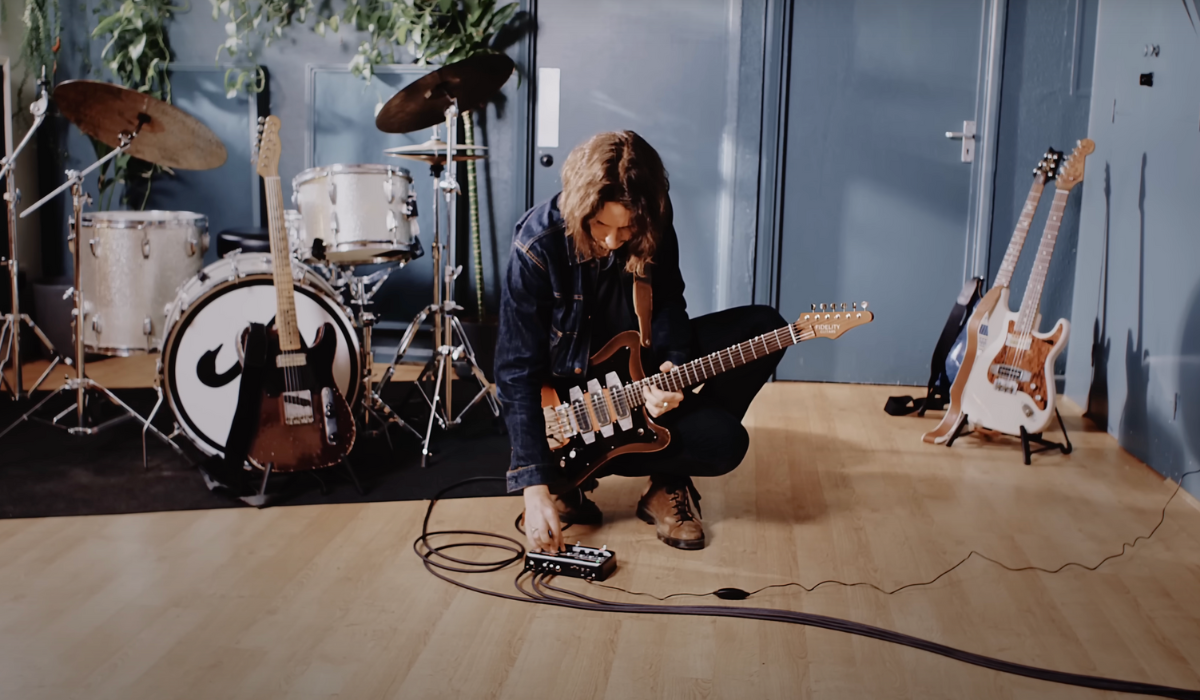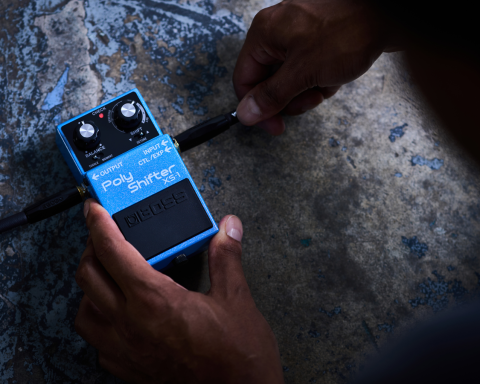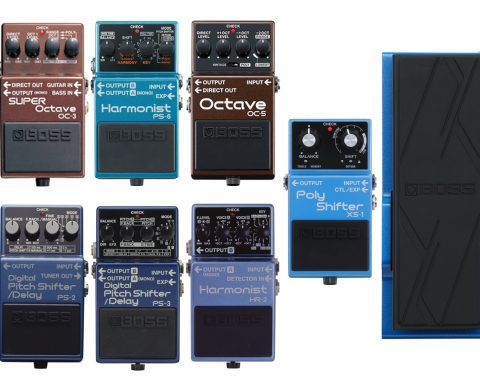Delay pedals aren’t solely for guitars. These pedals offer an incredible way of expanding the sonic capabilities of your instrument. Whether it’s for your synth, keyboard, drums, or electric violin–the world is your oyster, and the delay pedal is your sonic pearl. Today, we’ll explore a few instruments perfect for delay pedals. We’ll also look at some preferred pedals and settings to get you started. Consult The Delay Pedal Glossary if you’re wondering what “wow & flutter” means or the difference between “time” and “feedback.” First, let’s clarify a few common questions about using delay pedals with other instruments.
Acoustic Guitar with Delay Pedals
Delay works beautifully with acoustic guitar. In fact, artists like John Butler, Jon Gomm, Tommy Emmanuel, and Eric Johnson use delay pedals for fingerstyle acoustic guitar. It adds a new dynamic to playing, filling in the gaps and making it sound like there’s more than one guitar player. Delay provides everything from long, drawn-out repeats to Chet Atkins-style slapback. Whether you use an electric acoustic or run an XLR into the pedal, you can get some interesting sounds with delay.
Delay can be a secret weapon when fingerpicking or strumming an acoustic guitar. It’s like having multiple guitars playing in harmony, each echoing the other’s notes. If you’re a percussive acoustic guitarist who taps the guitar’s body to get a drum sound, you can accentuate beats with a delay effect added.
"Delay can be a secret weapon when fingerpicking or strumming an acoustic guitar. It's like having multiple guitars playing in harmony, each echoing the other's notes."
If you reduce the volume or level of the delay pedal when using a guitar and have it with 2-3 repeats, you can create texture around chords. This approach provides a chorus-style effect that’s perfect for worship-style acoustic guitar. If you palm mute with a delay, you can create a rhythmic percussive sound with your guitar work as the pedal repeats your palm mutes. With a multi-head delay like the Roland RE-202, you can set the wow and flutter to disintegrate quickly on one channel and to repeat cleaner on the other. This setting provides two different sounds from the same pedal.
Top Tip: Use a sharp pick, palm muting, and shorter repeats to get precise repeats. However, for longer ambient style delays, opt for a softer pick, open chords, and longer repeats.
Sample Setting: DD-8
- Mode: Opt for Analog. It will bring a warm, vintage touch to your playing, but you’ll still have the digital precision in the repeats.
- Time: Keep it between 300-400 ms—just enough to add depth without overshadowing the original melody.
- Feedback: 2-3 repeats. This ensures the delay fades gracefully and doesn’t overwhelm the guitar’s sound. Acoustic guitars are more prone to feeding back, so if this is happening, reduce the delays.
"Acoustic guitars are more prone to feeding back, so if this happens, reduce the delays."
Bass Guitar with Delay Pedals
If you’ve ever wanted to know whether bass guitar works with a delay pedal, listen to “One of These Days” by Pink Floyd. This recording is one of the finest examples of delay on bass. The track also features delay on slide guitar and drums. Bass guitarists can use a delay pedal to keep a rhythmic flow to their sound. As bassists dictate the feel and groove of a song, this can be extremely useful, especially in a three-piece.
Delay is beneficial to any genre of bass player. A rhythmic delay can transform a song, whether you’re into funk, slap bass, or shoegaze. It’s like adding layers of depth to every note and turning the sound of one bass player into multiple players. Kings Of Leon’s “Closer” is another excellent example of bass with delay.
Sample Setting: DD-200
- Mode: Standard. It’s all about clarity and keeping the groove as clean as possible.
- Time: 300-400ms is perfect for short, rhythmic echoes akin to Pink Floyd.
- Feedback: Keep it low, 1-2 repeats, so that the delay won’t drown out the precision of the riff or muddy the low end.
Keys and Synth with Delay Pedals
From swirling synth leads to digital piano performances, delay can make every note resonate longer and allow you to punch out of the mix. When you add delay to piano, especially a longer delay such as 300 ms, it’s like playing in a vast, echoing hall. This can add incredible weight and vibe to your sound.
When we crank the delay to around 600 ms, the sound gets spacey in the style of Vangelis’ Blade Runner score. This is a strong starting point for creating some fascinating soundscapes. Remember, the longer the delay, the fewer repeats. Otherwise, single-note lines might get lost.
"When you add delay to piano, especially a longer delay such as 300 ms, it's like playing in a vast, echoing hall."
Sample Setting: DD-200
- Mode: Shimmer adds a touch of ethereal magic to synth pads.
- Time: 400-600ms will create a sense of vastness and is excellent for sci-fi synth sounds.
- Feedback: Moderate, 3-4 repeats. It’s all about sustained ambience with this setting.
Modular Setups with Delay Pedals
In the world of modular setups, delay is a game-changer. It can turn a simple lead line or single wave into a different animal and act as an additional instrument to play patterns. This approach can create a dynamic backdrop for your music. Plus, if you don’t have an arpeggiator built into your synth or modular setup, a delay can act as one. Check out the DM-101 Delay Machine with modular synths and drum machines to get some cool sounds.
Sample Setting: DM-101 Delay Machine
- Mode: Tape Echo is warm, vintage, and perfect.
- Time: This setting is variable. It depends on the evolving pattern you’re aiming for. Try for 200-300 ms for shorter delays, or go all-out with 400-600 ms delays and accentuate the chord changes.
- Feedback: Go high. Let the textures evolve continuously and enjoy the oscillation.
"In the world of modular setups, delay is a game-changer. It can turn a simple lead line or single wave into a different animal and act as an additional instrument to play patterns."
Drums with Delay Pedals
Delay is wonderful on drums. One of the most famous uses of delay on drums is Stewart Copeland’s Roland Space Echo on “Walking On The Moon” and “Every Little She Does is Magic.” Copeland uses it predominantly on the hi-hats for just one repeat, so it doesn’t build up.
Copeland is one example of artists using delay pedals to enhance their sound. From snare drums to cymbals—a touch of delay can make every beat stand out. It’s like having an entirely separate drummer playing along. Delay on drums can build a completely new rhythmic base or provide an extra push.
Sample Setting: DD-3T
- Mode: Short Delay is sharp and precise.
- Time: 100-200 ms gives that snappy reflection.
- Feedback: Keep it low. Just enough to create a distinct echo.
Sample Setting: RE-202
- Mode: 5 (Delay + Reverb)
- Time: 100-200 ms provides a quick repeat.
- Feedback: 1-2 repeats.
Vocals with Delay Pedals
With delay on vocals, one voice can become a choir. It’s all about adding depth and dimension, from lead vocals to backing tracks. Use cases range from simple repeated vocal lines back to a swirling cacophony like Robert Plant on “Whole Lotta Love.”
A delay pedal with vocals can bolster the power of a vocal. Set the repeats low, 1 or 2, and the level set back so you can hear it, but it won’t overpower the vocal performance. This setting provides a sense of depth and weight to a vocal performance. Check out the video below and start at 2:02 to hear how Led Zeppelin used delay techniques.
Sample Setting: DM-2W
- Mode: Analog adds warmth and depth to your vocals.
- Time: 200-300 ms is perfect for a natural-sounding echo.
- Feedback: 1-2 repeats. Keep the vocals clear and crisp. Or try 3-4 repeats for a more ethereal vocal sound.
Sax/Brass with Delay
Whether it’s a sax solo or a brass ensemble, delay can create riffs or add more weight to brass solo sections as it does for guitar. If you’re going to play lead lines or solos, try adding 1-2 repeats and having the level of the delay set quite back so it adds the extra depth without overcomplicating the sound. However, crank up the repeats to create a new riff. Or build the song around the sax or brass instrument and start playing rhythmic sounds. Set the level to the same volume as the original signal, and you’ll be ready.
Sample Setting: DM-101 (Vintage Model)
- Mode: Standard. Clarity is key.
- Time: 300-500 ms. It creates a rich, resonant echo.
- Feedback: 2-3 repeats will fill the space perfectly.
"A common use of delay pedals with string instruments is to extend the notes. This approach can turn a single note line into something dramatic."
Stringed Instruments with Delay
Delay pedals are perfect for electric violins and to modernize string quartets. The effect can create an ethereal, haunting delay or bring out the pizzicato notes to build a track around a percussive section.
A common use of delay pedals with string instruments is to extend the notes. This approach can turn a single note line into something dramatic. If you accentuate the bass notes first and then play the treble lines, you have the illusion of multiple violinists. A bass player holding down the groove can help build a progression as you go.
Sample Setting: DM-2W
- Mode: Analog. It’s warm and natural.
- Time: 350-500 ms will add space for a haunting sound.
- Feedback: Keep it to 2-4 repeats to complement the string resonance and retain the original line.
Sample Setting: DD-500
- Mode: Standard for clear digital delay.
- Time: 200-300 ms adds a little slapback delay and won’t drown out the main rhythm.
- Feedback: Keep it to 1-2 repeats. Then try another mode with 3-6 repeats for an ethereal experience!
"Analog will give a warmer, more nuanced delay, whereas digital will provide absolute precision with no sound deviation."
Choosing the Right Delay for Different Instruments
One choice is between analog and digital delay. Analog will give a warmer, more nuanced delay, whereas digital will provide absolute precision with no sound deviation. But whether you choose analog or digital, multi-tap or reverse, it’s vital to understand your needs and select the pedal that ticks the boxes.
Do you need multi-delay? Choose something like the DM-101 or DD-8. Do you want a multitude of digital delays for absolute precision? Choose something like the DD-200 or DD-500 delays. Are you looking for unpredictability and analog warmth? Choose a DM-2W or RE-2 and get that lush warmth with flutter and subtle nuance that gradually degrades each time. Remember, there are no rules when it comes to music. Play what sounds best and choose the delay pedal that inspires you.






